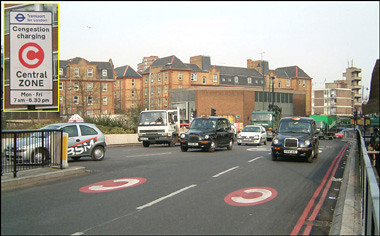
The other day the New York Times published an interesting article, Paying on the Highway to Get Out of First Gear, about the growing popularity of toll roads. From Virginia to Texas to California, people are beginning to be willing to ante up to escape gridlock.
"It's like everything else: you can fly coach, or you can fly first class," said Caleb Dillon, an X-ray technician in Riverside whose commute is an hour each way. "I'm not a rich guy, but I like having the option of saving time when I really need it."
The tolls have also succeeded in doing what no amount of cajoling and public service announcements could do: get people to car-pool.
I grew up with the prototypical US toll road, the New York State Thruway. It's engineering set the standard for the Interstate Highway System begun under Eisenhower as part of the Cold War (along with "duck and cover" drills in the schools.) But the idea of paying tolls just reminds me of the horrors of the Jersey Turnpike, a road I drove frequently in the early 1970s, stopping to throw in more coins what seemed like every ten miles. That wasn't efficient.
Toll roads raise all sorts of questions (Here's an interesting World Bank report on some issues.) I quickly thought of my own: are they just for the rich? Do they penalize the poor? Where will the money come from to build and run them, from private businesses or taxes? In either case, who makes the rules and sets the tolls? If they aren't profitable, who pays? Will making a road a toll road just redirect a lot of traffic onto alternative routes? Lots of problems here.
Looking into this, I ran across what seems a far more ambitious and perhaps better-targeted expedient that some cities have adopted to reduce traffic. Would you pay to bring your car into the center of an attractive big city?
Since February 17, 2003, thousands of people have paid a "Congestion Charge" each day for the privilege of driving in London between 7 a.m. and 6:30 p.m. From Monday to Friday, the fee has been 5 pounds (nearly $10) set to rise to 8 pounds ($15) in July. Wow!
Naturally there are lots of wrinkles. Residents, emergency vehicles, motorcycles, bicycles and buses are exempt or have very low rates. Buses and the tube (subway) may be more crowded at some times. Ingenious efforts to evade the cameras that enforce the Charge have proliferated.
A report six months after the Congestion Charge's inception found that "on average the number of cars entering the central zone was 60,000 fewer than the previous year, representing a drop in non-exempt vehicles of 30 percent. Around 50–60 percent of this reduction was attributed to transfers to public transport, 20–30 percent to journeys avoiding the zone and the remainder to car-sharing, reduced number of journeys, more traveling outside the hours of operation and increased use of motorbikes and cycles. Journey times were found to have been reduced by 15 percent."
Interestingly, the Congestion Charge is not a money maker for London. The reduction in traffic has been so great that revenue is less than expected.
This works well enough, I have to wonder if Manhattan is next? Bloomberg has said no, but who knows who the next mayor will be.
No comments:
Post a Comment